The statistics are sobering. About one in four women and one in six men are or will be survivors of sexual abuse in their lifetime. 34% of perpetrators are family members. 58% are known to the child and family. Only 7% are strangers. Tragically, we know that this can and does occur in local churches and homeschool groups. How can we help our children protect their bodies from those who would seek to harm them? Justin and Lindsey Holcomb join us in this week’s Homeschool Conversations episode to discuss issues of child protection and body image, all in the context of who we are as image-bearers of God. Does this feel awkward to you, or are you unsure where to start or how to have these conversations with your kids? Justin and Lindsey share some great tips and encouragement with us in today’s chat!
Be sure to check out all the other interviews in our Homeschool Conversations series!
Watch the video. Listen to the podcast. Read the show notes. Share with your friends!
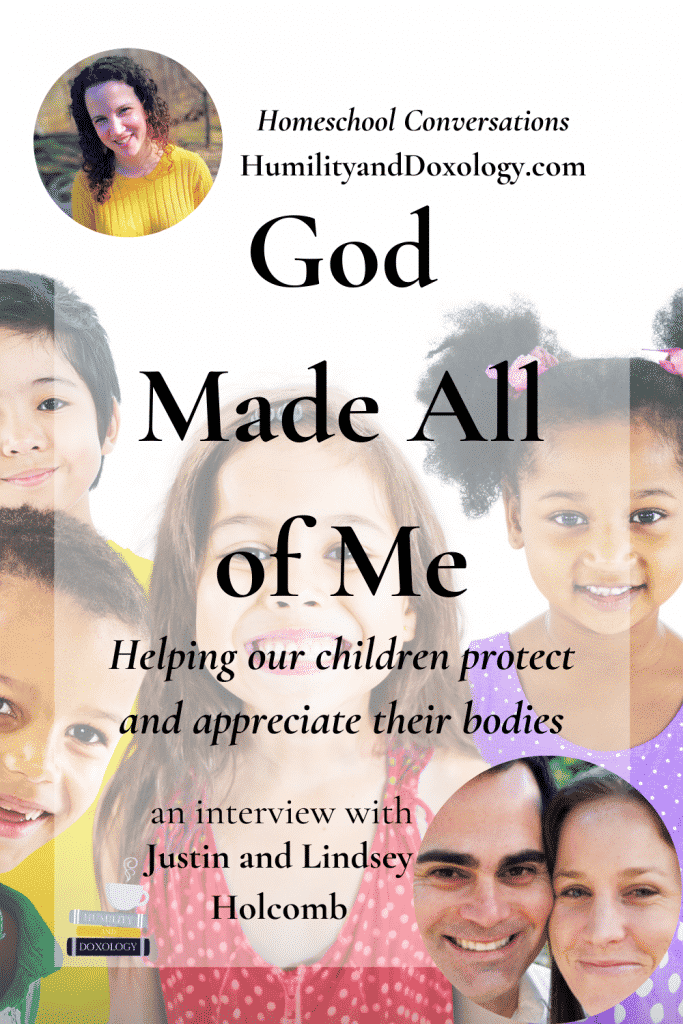
{This post contains paid links. Please see disclaimer.}
Who are Justin and Lindsey Holcomb?
Justin S. Holcomb is an Episcopal priest and teaches theology at Reformed Theological Seminary, Orlando. He serves on the boards of GRACE (Godly Response to Abuse in Christian Environments) and REST (Real Escape from the Sex Trade).
Lindsey Holcomb holds a master’s degree in public health with a focus on violence against women, and counsels victims of sexual assault and domestic violence. She has provided crisis intervention to victims of sexual assault and domestic violence and conducted a variety of training seminars to service providers, and she worked as a case manager at a sexual assault crisis center and domestic violence shelter.
Justin and Lindsey live in Orlando, Florida, with their two daughters.
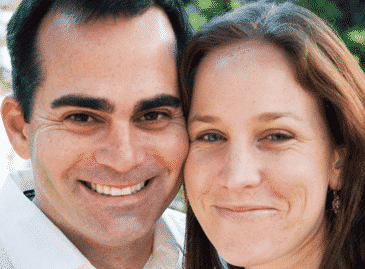
Watch my interview with Justin and Lindsey Holcomb
Prefer to listen to your content? Subscribe to Homeschool Conversations on Apple podcasts or wherever you get your podcasts so you don’t miss a single episode!
Amy: Hello friends, I am so delighted to be joined today by Justin and Lindsey Holcomb.
Justin is an Episcopal Priest and teaches theology at Reformed Theological Seminary, Orlando. He serves on the boards of GRACE, Godly Response to Abuse in Christian Environments, and REST, Real Escape from the Sex Trade.
Lindsey holds a master’s degree in Public Health, with a focus on violence against women, and counsels victims of sexual assault and domestic violence. She has provided crisis intervention to victims of sexual assault and domestic violence, and conducted a variety of training seminars to service providers. She’s worked as a case manager at a sexual assault crisis center and domestic violence shelter.
Justin and Lindsey live in Orlando, Florida with their two daughters. Thank you both for taking the time to chat with me today. I’m really excited.
Lindsey: Thanks for having us.
God Made All of Me: protecting our children from sexual abuse
Amy: Well, my family and I have one of your books for children on our shelf, God Made All of Me. We have really appreciated this book, it’s been a great one to read aloud with our children and open up conversations. One of the things I love about the book is that it really roots a child’s understanding of the value of their body in who they are as humans created in God’s image. Can you tell me a little bit about why you wrote this book?
Justin: I’ll go first. Lindsey, when we were dating, I was a seminary professor, professor at the University of Virginia and she was the case manager. I emphasize some of the research justifying why we’re doing this, and she is advocating and doing all the creative and the care-for-the-survivor type of stuff and I’ve learned from her.
I’m going first only because the stats set the reason, and there’s more reasons than that, but the big one, if you think through what– We wrote a book called Rid of My Disgrace about 10 years ago, and that was for survivors of sexual assault.

The numbers there are staggering, about one in four women and one in six men are or will be survivors of sexual abuse in their lifetime. The purpose of this is to try to prevent that from happening. We want people to not have to read that book about hope and healing, because that’s not their experience. The first thing is just preventative, because one in five children will be sexually abused before their 18th birthday. That’s the statistic. We’re not being dramatic, we’re not pumping those numbers up, it’s probably worse than that, so we actually put very conservative numbers on that.
This is important for your audience, because many people in your audience will be thinking that they’re safe, things are different just because there’s just less interaction with certain people that they assume would be dangerous. I don’t know what the statistics would be, but the statistics across the board are 34% of perpetrators are family members, 58% are known to the child and family, only 7% are strangers.
The rationale many people are thinking is, “Oh, well, our family is safe, and our circle is safe, and it’s all those strangers.” Well, they don’t have as many interactions perhaps socially, just because if you’re homeschooled, you’re not usually with a bunch of other kids and families all around. There’s a slight minimization of the interaction, but that’s not the threat.
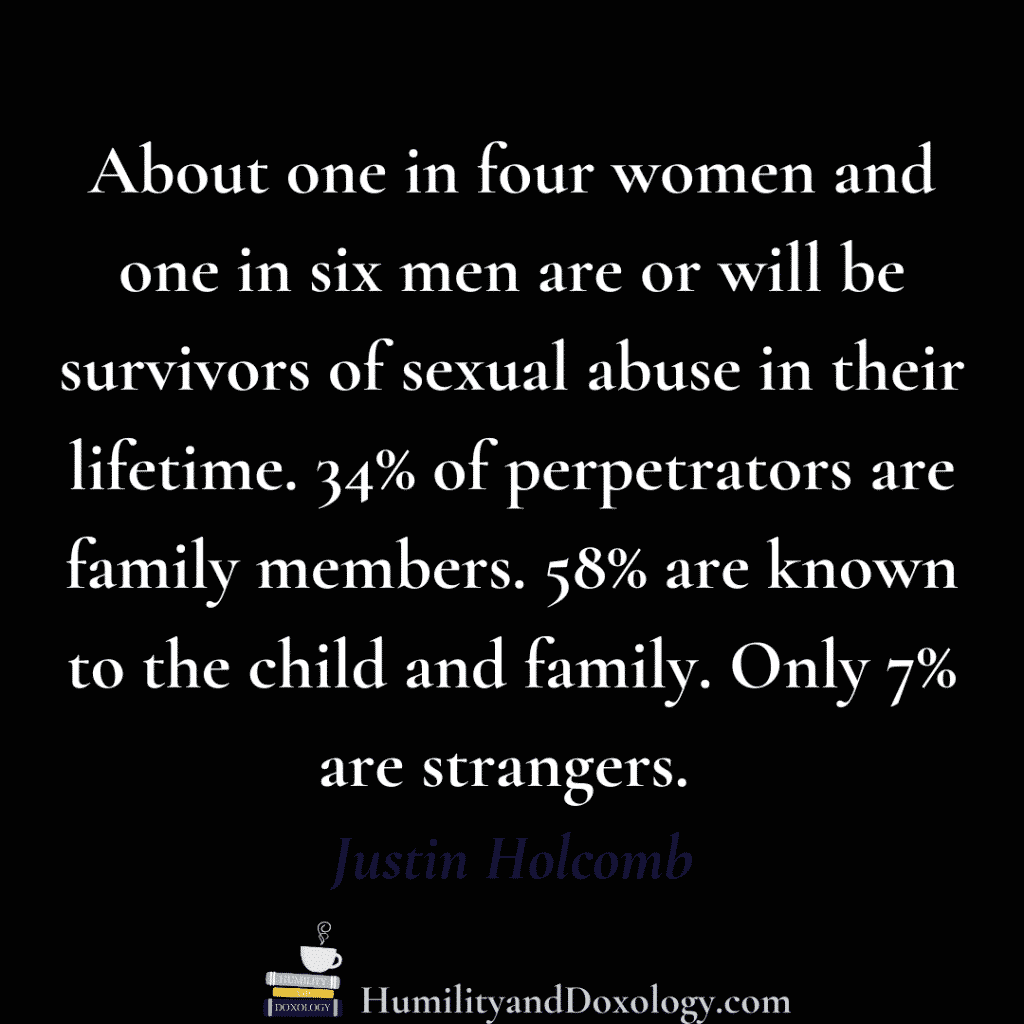
The threat is not strangers, people out there, it’s someone who’s known to the family or in the family.
93% are family members, or friends or acquaintances, known, trusted acquaintances of the family or the child. Those are the big ones.
The other major thing is that parents are frequently worried about fire safety, swimming safety, traffic, biking safety, and a whole bunch of other things. We live in Florida, so when we moved here, one of the first things move– Well, I moved back here, but when we moved here, our children were three and five. They were taking swimming lessons to make sure of swimming safety, “What do we do if there’s a fire?” How do you cross the street?
The book is to do personal safety, that’s the languages because we don’t want children to feel scared like, “Hey, mom and dad, why are we reading this book?” “Well, we want to talk about personal safety.” It minimizes– It’s not leading with fear. It’s just the big reason is to minimize because there’s a huge problem that’s not being discussed.
The other reasons because we had children at the time, and Lindsey was looking around and leading the charge on different books that were age-appropriate, and we had a pile of them. We noticed that there was something missing.
There was a Christian book that uses scripture, Christian language, and categories to talk about body and threats, just to frame the whole conversation. Lindsey just said, “Well, we’ll just make the book.” I don’t think like that, that’s how she thinks. I make things that exist really good or better, she creates things out of nothing. She thought, “Let’s create this book,” and then it went from there. Are there other reasons you can think of, Hun?
Lindsey: Sure. Definitely, those are all big ones. Like Justin said, there really wasn’t anything on the market that I felt comfortable saying, “I would want to read this with my kids or pass on to somebody else.” Around the time our kids were two/three and four.
One, they’re asking questions, and I saw within our friend group, nobody really was having these conversations.
I’m trying to figure it out, because I had been working in these roles with adult women, who were victimized when they were children and the general feedback was, “Nobody ever talked to me, nobody ever educated me, nobody ever protected me. Nobody ever listened to me, if I did disclose.” There just was no empowerment in how devastating that was for them, in addition to the shame and the guilt, and the blame and all those emotions.
It really made me think, “My goodness, it’s this model, they talk about in public health, where you’ve got to go upstream. You’ve got this problem downstream, but let’s go upstream and figure out like, why do people keep falling in the river?” I hate the bully, so I’m like, “The bully is these perpetrators.” I’m like, “If we can get ahead of these perpetrators and educate thousands of children, to be able to name their body parts and call it out or know who to talk to, who are some trusted adults that they can disclose to, how amazing? My work is done on Earth if we can do that.”
We found that parents weren’t having the conversations. They were worried about, “If I say it wrong, I’m going to mess it up,” and just avoiding it altogether. I feel like this book is such a great foundation, that then you can have further conversations that aren’t going to be weird. It’s weird to sit your kid down at 13, and have all of the talks between body safety and sex awareness, and then throw in relationships and healthy relationships. You’ve got to start small.
One, because their attention span is small, and then it establishes such trust and a sense of like, “Our girls know that we talk about these things, they talk to us about questions or any areas of concern they have.” It’s not perfect at all, and it doesn’t necessarily mean that you do all these things, and you’re 100% protected. However, it does mean you’re putting in such a foundation of open conversation, where we’re telling them over time as it’s developmentally appropriate, we’re telling them the truth.
When they hear something at school they’re like, “That is definitely not right,” from their peers, or if something uncomfortable happens, then we’re going to be able to intervene right away. That’s our hope and it’s the same thing, we wear our seatbelts, they’re not foolproof. We teach swimming safety. Like Justin said, we teach our kids every lake has an alligator in Florida, it’s not foolproof. However, it is building such a forcefield that it reduces the vulnerabilities significantly, by having these conversations.
That was the reason, we found people were not having them. Even to this day, I’m like, “You have a 15-year-old, you’ve never had this conversation, start with our book. It’s going to be a little bit awkward, but here you can go.” It’s a tool for parents to hopefully, mitigate some of those awkward conversations because you’re reading. We found that with our girls, it was really helpful by just cuddling up on the couch and reading the book.
They call it the body book, that’s what they termed it, and they’re like, “You’re going to read the body book again?” but it works. It does, it has provided such appropriate language for talking about these topics.
Justin: Something Lindsey just said was the goal of the book, which is I think, key of all of this is, to make a tool for parents and caregivers. I’m going to highlight that because there’s a few things parents can do, and it’s actually really easy. It’s not as difficult as most parents think, which is, help them understand what sexual abuse is. You can talk about in a way– You don’t just start the conversation and say, “Hey, four-year-old, there’s a thing called sexual abuse.” There’s ways of getting there.
The tool is to do one thing, help parents communicate, and help children understand what sexual abuse is. The other, is to empower them to avoid abuse and protect themselves, and then to teach children to tell someone immediately.
Those are huge pieces right there, enormous, because most perpetrators don’t just dive into the deep end of abuse. They’re grooming, they’re preparing things. For days, weeks, months, they’re grooming. Knowing what perpetrators do, we wrote a book knowing the behavior and characteristics of perpetrators to help families and kids have the tools to see it, and how to respond and things that a perpetrator would do to slowly inch closer and closer and closer with touch, and words, and secrets. We’re trying to pull the rug out from underneath them as quickly as possible.
Honestly, it’s one of the most awkward stories in that the story is watching another family have the conversation. We didn’t have cute animals having conversations about animal body parts, it’s literally a family doing the conversation, but we did that on purpose because we wanted moms and dads and caregivers and children to basically have a little bit of distance, to observe another family having this conversation. It’s literally this illustrated family is doing the conversation for the parents.
That way, there’s a little bit of distance, so it’s not as awkward. We say all the body parts, the proper names for body parts, so you don’t have to immediately, but– By the way, just so all the parents know, the favorite page of all children is the proper-names-for-private-parts page. Children love that page. We have the fun for you by getting them to giggle and all that stuff. We can talk forever on just that one question. I’ll be quiet, so we can move on.
Amy: Well, I just want to reiterate what you guys are saying, this is exactly why I wanted to have you guys on. I was telling you a little bit before we started recording, this is something I think my parents did a really good job doing growing up. This was my experience, my earliest ages, we were talking about proper names of body parts. There were very open conversations about like, “Hey, we’re going to go be with extended family or at this church camp. I want you to know.”
I remember multiple times my mom telling me like, “You can tell me anything and it doesn’t matter if it’s my best friend, or someone that we’re related to. I will believe you. If anyone makes you feel uncomfortable, you come tell me right away.” Just how safe that made me feel, and I never felt scared or awkward about that. That was just more like, “Oh, hey, my parents would believe me and I know that no one gets to be tricky around me.” That’s something I talk with my own children about.
I think sometimes there is that feeling of like, “Well, if I say it wrong, that awkwardness, I don’t want to say the wrong thing,” but it’s so much worse to not say anything at all than to maybe say it awkwardly. I’ve even talked to some of my kids, and we’ll be having a conversation, I’ll be like, “Man, sometimes this is really awkward. Mommy’s feeling really awkward, but just because we’re feeling awkward, that doesn’t mean we can’t have the conversation. If you feel awkward, mommy feels awkward sometimes too and that’s okay.”
Justin: I’m on a sabbatical, so I’m actually just doing some fun-reading now. My fun-reading was something about parenting, but it mentioned that one of the most powerful things for children is a deep sense of safety. Just hearing you describe what your parents did is moving, because that’s the stuff that we say all the time, but it’s just cool hearing another family do it. I’m feeling safe.
The idea someone is so intentional about– I’m just imagining a kid feeling like that and imagine what my girls feel like of a deep sense of safety for their well-being, and for their role in the family, and that someone’s there behind them in the corner, watching out for them. That’s just a cool experience for a child to have. Listening to what you just said, some parents think this is an awkward conversation, but what you just described was the other end of the spectrum of awkward.
I just imagine the kid hearing that, and just sitting down and being able to breathe out loud and sigh relief and be like, “Ah,” because the world for the kids is crazy already. They’ve got TikTok and weird stuff happening there. They have kids at school saying things, calling them names or their friends down the road. They have family members, who were sometimes weird and awkward and creepy perpetrators. There’s a whole bunch of stuff out there, so I love what you just said. It was powerful. It was beautiful. Just imagine a child feeling safe like that.
That wasn’t the norm back then. I’m assuming ’80s, ’90s, that was not the norm. I think it’s so simple just to say those things, but if most adults our age did not grow up that way– I got a video when I was like 13 and that was it. There really wasn’t even a conversation after the video, and I don’t even know what the video was about, but it was awkward. I remember I was uncomfortable, but if most adults our age did not grow up with parents like yours, then we don’t know how to have those healthy conversations though.
If it’s a very simple conversations of saying, “I believe you no matter what happens and who it is, you tell me and I will believe you.” That’s simple. You don’t have to go off to go and get a PhD to have that conversation, but most people don’t have what your parents equipped you with. It’s unfortunate for our kids, but we can’t just be like, “Well, I didn’t grow up with that.” There’s no excuse. We know better.
The perpetrators, they are very smart. They will groom. They will take their time. They are conniving. They are purposeful.
It’s not off like, “Oh, it just happened. I wasn’t even thinking about it.” They are calculated. It is evil. As parents, one of our jobs is– Well, it is to protect our children, and this is part of it. We have to fight. We have to go ahead of them and be– Ahead of the perpetrators with education and conversation, so kudos to your parents.
Amy: I’m really thankful. As most kids do, you take for granted what you experience and I realize more and more now, how unusual it was and I’m very thankful for that.
Some of the Myths About Talking to Our Children About Body Awareness and Abuse Prevention
We’ve touched a little bit on some of these myths that maybe people have, or believe.
Some of the statistics Justin, you already mentioned, but I would like to maybe dive a little bit more into some of these myths like, “Well, my child’s too young to have this conversation,” or like, “Well, we hang out with church people, so we’ll be fine.” Are there any other myths you think that parents really need to erase from their mind? Lindsey, how about you [crosstalk].
Justin: Go for it, Lindsey.
Lindsey: Well, I was going to say you jump in because I’m trying to think through my list of ones.
1. They’re Too Young
Justin: Let’s go for the first one is, “You’re too young to have it.” Again, I’m saying what I learn from Lindsey. I remember her just saying how important body awareness was. We had two girls and she’s changing their diaper, and she’s like, “There’s no age that’s too soon.” She’s changing their diaper and actually having a conversation with them like, “Hey, I’m going to change your diaper and this is what I’m doing.” She just described– She normalized the body parts and private parts weren’t something to hide or to feel shame about.
I’m sure we’ll get to it, but we already talked about the appropriate names, proper names for body parts. We’re not saying you can never use a nickname or whatever people have, but it’s good to actually establish that because using playful names, well, one, it turns a private part into a play thing, which is what a perpetrator is trying to do. It also communicates like, “That’s my elbow.” It’s just what it’s called, it’s an elbow. “That’s my ear and here’s the back of my knee,” that’s just what it is.
When you start getting to certain parts, you’re like, “Oh, that’s your ‘lily’.” Suddenly it communicates to the child like, “Oh, this is something of which we do not speak apparently, and I probably shouldn’t talk about it. If someone touches it, I shouldn’t say anything because it’s shameful.” Actually just doing that communicates awkwardness and shame. When Lindsey was doing that, it just normalized it.
That was huge. Then, the conversation, like Lindsay said, having the conversation at 13 and 15– If you haven’t had the conversation, go for it. We’re not trying to shame the people that haven’t had the conversation, but having that conversation regularly, that’s a path that’s been trodden with our children. Is trodden a word? I’m sure it is-
Amy: We’ll go with it.
Justin: -but same thing happens. You see where people lay sidewalks down. One time we were at a hotel and we were looking down, and I saw where the sidewalk was and then I saw where everyone else just walked. They just created a pathway right there, because that pathway has been blazed by many people walking there. I think of that like, “That’s the pathway that Lindsey and I have walked with our children on a regular–,” When we come back from a date, we go, “Hey, how did you feel with the babysitter?” “Pretty good.” “Any weird questions?” “No.” “Did she take pictures of you with her phone?” “No.” The conversations we’ve already been talking about.
Having those micro conversations, just little drips here and there works really well.
2. Perceived Safety
The other one is the perceived safety. I don’t want to scare people, so I’m not trying to scare people with these numbers, but a perpetrator is like a lion stalking prey. A lion is hungry. It will lay there all day for the right time to strike. Male perpetrators, who violate male children, have an average of 150 in their lifetime before they get convicted. A perpetrator who-
Lindsey: That’s 150 separate victims.
Justin: Separate victims. They know exactly what they’re doing. They know how to lie. They know how to wait. They know how to do things when the time is right. Let me tell you this one, half of all sexual perpetrators against children have perpetrated with other children in the room, and about 35% perpetrate with another adult in the room. Why? Because when a child says, “Oh, well it happened in Sunday school.” All that person has to say is, “Really in Sunday school with all these children around?”
They’re trying to minimize the credibility of the child, “Really, with another adult in the room?” They’re looking for the child, who has behavior issues, who might not be trusted. There’s some quotes, which I will not read because it’s disgusting, but I’ll summarize them. A convicted child molester was interviewed by a therapist and said, “We want to understand, tell us what’s going on.” He said, “Oh, I would look at a group of like 20 kids and I’d find small handful that I was attracted to. Then I’d look for the ones that wouldn’t have as much oversight from family, and then I’d look for one that might not be believed, and then I just take my time before I would strike.”
It was like a lion stalking a little antelope that’s clueless about what’s going on. The stats I gave earlier is that, because you’re in the church you might think you’re safe but the problem is that one third are family members, and the other 60% are people in the circle.
I’m on the board of GRACE, Godly Response to Abuse in Christian Environments. I can tell you that the statistics of abuse in the church are not encouraging at all. As a matter of fact, abuse in the church gets hidden and gets theologically covered over, because we don’t want to bring out the allegations against the pastor because we don’t want people to think badly about the church.
There’s so many justifications people have for covering up and hiding abuse. Look at Ravi Zacharias. That’s the newest one, but just look at the list of people that got the benefit of the doubt and then, you find out that they’re dirt bags who abuse other people on a regular basis, they’re predators. The church should be the place that is unbelievably safe, where we walk in the light, we say true things, but people’s experience is that, that’s not the case.
3. Talking about this will scare our kids
Lindsey: The only one that I’m going to add to that, because he listed off some really great ones is, I’ve heard some parents say, “If I talk about sexual abuse, if I talk about any of this, I’m going to scare my kid.” I’m like, “Well, there is a way that you can talk about it. You can read our book and you can have these small conversations with them, so you’re not just dumping all this.” There has to be developmentally-appropriate conversation. 100% would say that.
Actually, what ends up happening is, if you do not talk about this with your children and something happens, or something makes them feel uncomfortable and it’s kind of in that gray zone, they are going to think, “My mom and dad don’t talk about this. They don’t know about this. If I bring it up, I’m going to freak them out. I’m going to scare them. I’m going to get in trouble.” There’s so many things.
The kid’s head’s going to be swirling, as opposed to a child who has been having these conversations with their parents. They’re going to say, “My mom and dad know about this. I know that I am believed. I know I was told X, Y, and Z, to come to them that I am not at fault, this was not–,” All those good things that your parents told you. They will come to you with complete trust and hope that you’re going to advocate for them, and stop this and believe them, as opposed to, if you don’t have the conversation, they’re going to literally think, “I can’t tell my mom and dad this, they don’t know about this, and this is going to scare them. It doesn’t work.” You’ve got to throw that myth out.
4. We stay away from strangers and creepers
There is one more. I think people will think like, “As long as I stay away from the stranger in the bushes–,” And Justin’s talked about this with, it’s the acquaintances, but even more so, they’ll think, “Well, the people I’m around are Christians. They’re healthy. They’re not mentally ill. They’re not weird, creepy. They don’t look creepy.” There’s some people that just give you that creepy vibe, but they’re like, “They don’t look creepy.” Well, unfortunately, perpetrators don’t necessarily look creepy. They are your all-star coaches and doctors and lawyers and police officers, dentists-
Justin: Pastors.
Lindsey: -[crosstalk] at the church, pastors. They don’t necessarily look creepy. I think I go around and think everybody looks creepy just because of the work we’ve done, but for the most part, new people that are normal. These perpetrators don’t look creepy. They are the all-star American hero of the neighborhood. When an allegation comes out, everyone’s like, “Oh, my goodness, they were so involved with church and school, and they’d been a teacher, or a substitute teacher.” You can’t just say, “I’m going to just stay away from those that are mentally ill or this dark side of town,” or “This doesn’t happen in our church.” Unfortunately sexual abuse is widespread across all socioeconomic levels and races, religions, ethnic groups, cities, counties, towns, you name it. It does not discriminate.
Appropriate Conversations to Have at Various Ages of Child Development
Amy: Both of you have brought up a couple of times like, “We’re having this conversation at age-appropriate levels with our children.” I’m imagining there’s someone listening to this and they’re like, “Oh, my goodness, I don’t even know where to start.” Could you give us maybe just– I know this could be long thing, but a short example of where we’re talking about a toddler. Obviously, we’re naming their body parts, and then they’re like two or three or four, sort of the stages, what would be appropriate to be saying to them at different ages along the way?
Lindsey: That’s a really good question. This book is geared for two to eight-year-olds. You could read the whole thing with a two-year-old versus a five or an eight-year-old and it goes through appropriate and inappropriate touch. It names the body parts, those things need to happen at two, three, five, seven, eight, and all the way up.
With that being said, I would say, like Justin said, when ours were babies and I’d be changing their diapers, I was already starting to name their body parts like, what I am cleaning, what I’m washing, and I would even– They were babies and I’m like, “It’s okay because I’m your mom, your dad. These are the people that are safe to be helping you, but this is your body.” I just went overkill. You can start that, make that conversation regular. It’s not like we talk about this 24/7.
I don’t want people to hear this and be like, “Oh, my goodness, I’ve got to work this into all facets of our day,” but just make it so routine and normal, that you’re not intermixing it with like other weird language and other cutesy code names. What ends up happening if somebody does touch them or show them something, but they’ve been learning to call their private parts their pocket book, well, then that is not going to hold up in court. That will not work out with a police officer or a detective, because then the perpetrator’s like, “Well, I showed her a purse. I don’t know what you’re talking about.”
I think, from the very get-go you can start with our book all the way up. There are certain things– Our girls are now 10 and 12. If you Google age-appropriate– It’s called sexual development health, there’s certain ages, around age five, kids are really into their private parts. Boys, Justin can agree, they want to show their private parts. I’m sure most readers or listeners that have boys, they’re like, “Yes.”
Justin: Why did you point to me?
Lindsey: Well, just stories when you told me you were in kindergarten.
Justin: I know. I did. Back when I was in kindergarten, back in kindergarten.
Lindsey: Just to clarify. I don’t want parents to worry like, “Oh, my gosh, my kid is showing off their private parts.” They’re are very appropriate things when you’re five and six, but I would say, you know your kids. I think you can have all of this conversation around two, and then you just keep on developing and as they get older. There’s not certain parts of the book that only needs to be mentioned when they’re two and then, when they’re three. You need to mention from the get-go proper names of the body parts, start talking about appropriate and inappropriate touch.
We don’t use bad and good touch, and we can get into that later, but you start really going through that. You start identifying who are people that make you feel safe and that may change over the years. Especially as they meet different people and get into school, and have interactions with other adults that start making that list. That will develop and the questions are going to develop.
Our ten-year-old was asking the other day, she was like, “How do people abuse people?” I was like, “Oof.” That’s a question at age 10, that she wouldn’t have asked around 5 and 6, and I would not have wanted to walk her through what that looks like, and how and why. Even still at age 10, I’m like, “Oh, my goodness.”
I won’t have the same conversations at age 10 that I will, when she’s 16 or 18. I work in the world of sex trafficking, doing grant writing and marketing behind the scenes, and they know a little bit about what I do, but there’s certain things that I’m still protecting them from. I’m like, “You’re 10 and 12, I’ve got to do as much as I can to shield you, but still prepare you.” I’m not able to sit and say at age two versus age six. At age six, you start talking about touch versus age two you talk about naming the body parts. I think you can do all of that, that’s in the book from the get-go. We picked age two, just because I think they’re looking at books more often.
Justin: Well, something I learned from Lindsey on age-appropriate was just talking about sex in general, the where-babies-come-from conversation. I came home from being gone for the day and came home and the conversation had taken place at a different level than it had ever taken place before. I walked in and the girls were giggling, and they had a fun time hearing about how babies are made, but what ends up happening was they– At one point, one of them said, “Hey, where do babies come from?” Lindsay said, “Just answer the question.”
Answer the question they’re actually asking, not the one that you’re afraid that they’re asking and, “Oh, they come from the mommy’s belly from this area.” “Okay.” That was good for like, oh, three to six months and then there’s like, “Oh, well, how does the baby get in there?” “Well, God takes a piece from dad and the piece from mommy and makes the baby.” “Oh, sounds great to me.”
Well, I would have been talking about other very specific things a year earlier than I need to do, so that’s a good rule-of-thumb is, answer the question that they’re asking and not the one that you think they’re asking as an adult. They can always ask another question, which has been huge. Coming back to the issue of abuse, we talked about– Lindsey already talked about them, but private parts, touch and then, awareness. Early on, is awareness that you can say no to other people touching you at all. If you feel awkward any type of touch, grandma, grandpa, uncle, aunt, any type of touch. That’s early on.
Now, that gets– You build on that. You talk about tricky people early on. Tricky people can last for a while, and then, you start saying, evil doers or people who do bad evil things. You ramp that language up when you have a sense that that child can handle that category without scaring them like, crazy. I still remember one daughter heard– I just want to be really sensitive for people who are listening. I don’t want to start throwing words around, but somewhere she’s heard the word “rape” and she’s looking at me and said, “What’s rape?” and I was like, “Ooh.” I started crying because I cry a lot, and I was like, “Go talk to mom.”
I can’t tell my 12-year-old what that is. Well, they already had the conversation, she was still processing a little bit. Well, the 10-year-old daughter hasn’t thought about that. Right now, we’re still talking about, “Oh, well, they touch your private parts when you don’t want them to.” That’s a good-enough answer for her right now. She doesn’t need to know the horror of the details of what takes place.
I think that, answer the question they have, try to protect them from the trauma of the imagination of what’s happening without giving them a false sense of security in themselves. You want them to be vigilant. Different children at different ages are going to have– I think that’s more of the principle to go with.
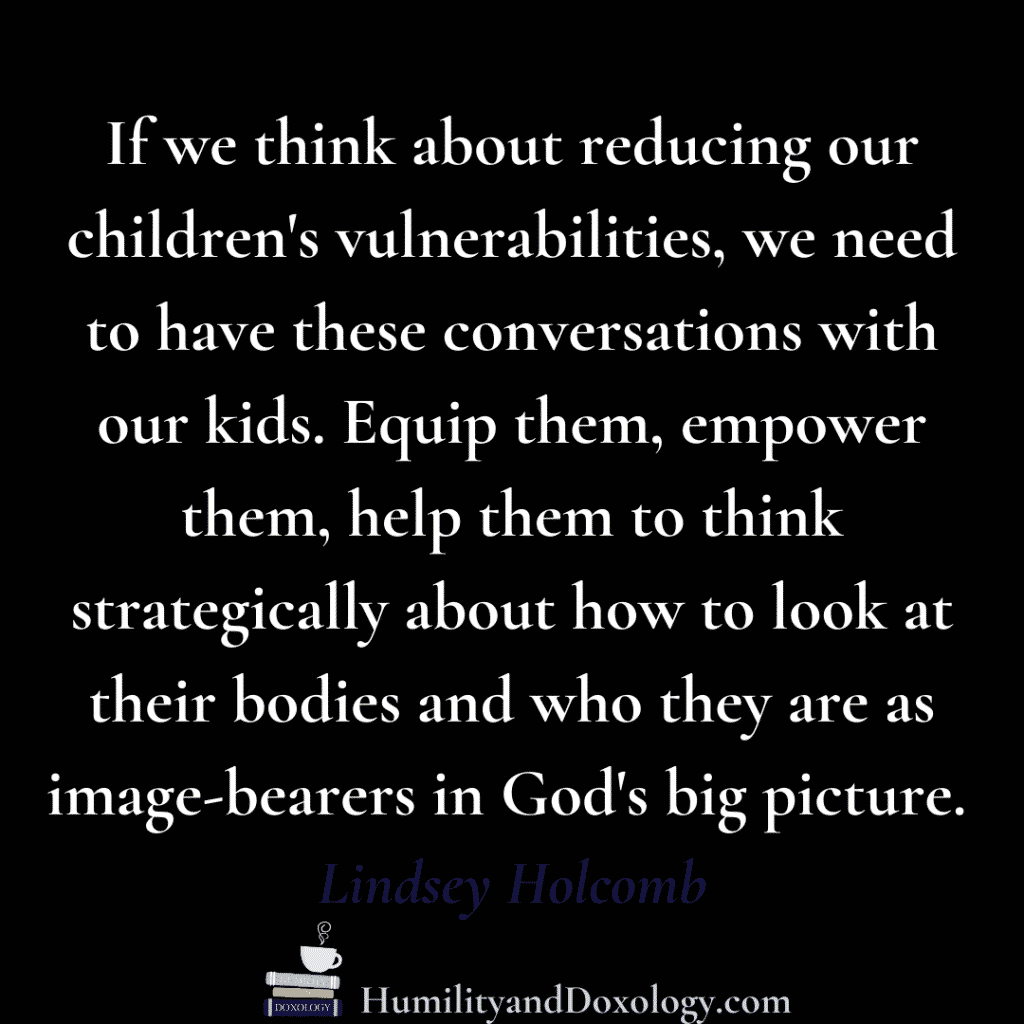
Lindsey: Yes. I would add, keep it simple too. Like Justin is saying, answer the question. Keep it simple. When I say name the body parts, I’m not saying teach an anatomy lesson. Just keep it simple and answer the question, and they will let you know when they’re done. I think, as all of us with the younger ones know, that they don’t want a whole lecture. That’s not going to help or work at all.
One thing that we did is when they were little, I would sit with them at the table and we would just go through some scenarios. When they were young, they were really simple scenarios. Like, “If you’re at the park, and somebody says, ‘can you help me look for my bunny’ what would you do?” Now, as they’re older, our scenarios have changed just because of where they are and just life experiences, and just a little bit deeper conversation.
I think that’s another example that you can just gauge it. Your kids are going to be different. You have so many ages in your family, and I think for you, Amy, you’re going to talk to your older ones very different than your six-year-old, and just gauging it. Every six-year-old is going to be different, whereas our daughter who’s now 12, she was asking like, “Okay, I know a guy takes a little bit of mommy and a little bit of daddy and puts them in the tummy, but how and why?” She really wanted to know more, and our youngest one was right along in the mix.
I was like, “Well, you guys are four and almost six, let’s have this conversation.” As opposed to– We have a lot of friends that are just having that conversation in fifth grade. Is one better than the other? No, I think it just depends on the child too.
Amy: Yes. I just want to also mention that from our family’s personal experience and our family devotions in the evening, we just read through the Bible. We go through, and then we start back at the beginning. That actually is another way that some of these topics like assault, even, these really hard topics, to make them something that– Not that they’re easy to talk about, but that happens in the Bible quite frequently.
You’re reading it all out loud together as a family, and someone asks a question, and then there’s a way in which you can answer questions with a wide range of ages, that’s appropriate without freaking anybody out, but that still dealing with these as things—“Things our family can talk about.” It’s like, “This is within the bounds of things our family talks about.” Just reading the Scripture, and not being afraid to read those hard chapters with your family, I think can also be a way to make some of those conversations, a little bit more natural.
Justin: I love that because then, it gives you the category of a narrative, and it also gives you language of how the Bible refers to that, which is sin. It’s not just some bad thing out there, it’s a crime and it’s a sin. It helps frame it, and it’s interesting for the kids to be like, “Oh, that’s in the Bible?” “Yes.” “Why is it in the Bible? That’s so bad mom and dad.” “Because it’s sin and this is what Jesus is coming to fix. This is why, it’s that bad.” I think that’s a brilliant thing to do. I love that.

Secrets -v- Surprises
Amy: Okay, I have one more question I want to ask about this, and then I want to talk about your new book, which I’m super excited about. I did just want to touch on the thing Lindsey brought up earlier, the inappropriate versus appropriate. You guys talk about that in this book, use that terminology or secrets versus surprises. Why does this terminology matter?
Justin: Well, I’ll do the secrets and surprises, and you go for appropriate inappropriate touch, if that’s okay, honey. Perpetrators will use the categories of secrets. The reason we just throw out the word secret and use the language of surprise, because secrets are usually information that is supposed to be secretive, exclusive, and isolates. There’s numerous reasons that we use the language of surprise, because surprises usually involve other people, and they’re in good news. It’s surprise parties, or, “Here’s a present,” or “We’re going on this trip,” or “So-and-so’s coming over.” Like, “Yes,” as opposed to secret, which is isolating and scary.
The main reason is because the perpetrator will use the category of secrets, “Let’s keep this a secret between you and me.” You know you’re not allowed to lie and say that you can’t– Just letting him know, you don’t tell secrets, or you don’t let anyone have secrets with you. You don’t keep secrets with people, very rarely are you going to have an issue with this. It is fun because our girls have heard this so many times, so few years ago, one of our daughter’s friends is like, “Hey, can I tell you a secret?” She’s like, “No, no secrets. I cannot hear a secret.
She’s like, “I want you to come over to my house for my birthday party. I can’t invite everybody.” We’re like, “Okay, that’s different. That’s a surprise.” That’s the reason to stay away from secrets, because perpetrators– One of the main tools of a perpetrator is the category of secrets, to keep the child quiet and to keep the evil going.
That’s the category to threat– “If you don’t keep this a secret, your mom or dad might get hurt,” or “I’ll go tell on you and you’ll go to jail,” or “Your mom and dad will be really disappointed and it’s our secret because dirty things happen to dirty children, and you apparently are dirty. I’m here to help you, but I’ll keep it our secret to help you.” That’s how they talk to them. Again, you’re pulling the rug out from underneath the perpetrator.
Inappropriate/Appropriate Touch -v- Good/Bad Touch
Lindsey: Then, we use the language appropriate and inappropriate touches because when we started doing research and thinking through the words good and bad, just how confusing that can be to kids, because we, as adults, we can frame, what is bad touch. We might even call evil touch, but we know what’s bad touch but to a child, bad touch can sometimes– It can feel really confusing. It can feel good.
I can go into more examples of that, but it might feel really good, it might be– And then, good touch can feel bad. It made it too complicated to get into– It had too many opinions. For example, sometimes children that have been abused struggle, because they might say as they get older, they’re like, “I was abused by my grandpa. I would be touched constantly by him and it felt really good, because I wanted his love, I wanted his attention, but it also was wrong. It made me feel really bad and dirty.”
There’s just so much confusion and then they’re like, “What’s wrong with me?” and “Did I want this, did I not want this?” There’s a physiological response sometimes to a body like, sexual touch can feel good in a certain way, even though it’s bad, and that can be for a child. That’s really confusing to be like, “My body responded in a certain way and it felt really good to be touched in this manner, but I didn’t like it in my heart and my head, but my body was–,” There is just a lot of confusion there that can just bring in shame.
Appropriate and inappropriate touch were better categories, to really frame, “What does society say? What does God say is appropriate and inappropriate?” without any emotion added to it or feelings or opinion or not opinion, but kind of just that physiological response. What would you say, Justin? That’s a hard one sometimes for me too.
Justin: I think you nailed it. I think you said it perfectly, which I haven’t heard us, or you talk about before. Which is sometimes the inappropriate touch, abusive touch, feels good emotionally because it’s attention from the person. When abusive touch feels good physiologically, that’s where it’s really confusing, because you’re mixing pleasure and pain together and it’s distorting true pleasure. I was abused when I was 10. I can tell you what happens to a 10-year-old’s body when certain private parts are touched it is very confusing when you were thinking that felt good, but that was really evil and you slam those together.
Amy: Especially if it’s done by someone you trust too. That is a whole other element. If it’s a creeper in the bushes or some stranger, you can separate, but when it’s someone that you know that has been remotely kind, especially with grooming, I think it’s a little confusing.
Justin: If you’re 6 and it’s your 12-year-old brother. If you’re a six-year-old girl or boy, but if you’re younger and your 12-year-old brother, or your dad, or your uncle, or your favorite Sunday school teacher, or your coach. The mixture of emotions, I think that’s the confusion right there. It’s just easier as clunky as it sounds inappropriate touch, children will figure this out, this has not been an issue at all in the conversation. Staying away from good and bad touch, just for the sake of your future child who might need to have a different category to interpret what happened to them.
Amy: Yes, words matter, it’s good to use appropriate words to talk about these topics.
God Made Me in His Image: Body Image for Children
Well, let’s transition a little bit to your new book, which might sound like we’re talking about a different topic, but really, as I was looking ahead at the book that has not yet been released yet. This book is dealing with children and body image. It really though comes from that same foundation of who God made us to be, who we are as image-bearers of God. While it might seem on the face of it, all, these are two different topics. They’re really talking about kind of the same thing.
I should say the title, the title is God Made Me in His Image: Helping Children Appreciate Their Bodies. I could imagine somebody being like, man, you’ve already blown my mind. I need to be talking tabout protecting their bodies with my young children. Surely body image is not something I need to be talking to children about!” What would you say to that person?
Justin: Show abuse statistics and that’s what’s happening. We can tell you stories. We can tell you stories about how both of our girls who are probably average child size or smaller, called fat, their friends being called fat, it’s in their mind already. Children are hearing it, watching it, seeing it. I can give you some statistics on this, but by the age of six, the majority of girls start to express concerns about their weight or the shape of their body. Six is a pretty early age to start being critical of yourself.
Half of American children between first and third grade, six and eight are worried about their weight.
One-third of them have already reported dieting by the age of 10 or 11. I think it’s 80% of girls have done restrictive eating at some point. The average age of child dieting is 10. That’s huge and it’s not just for girls, boys are just as worried about body image. Little boys should not be worried about how much chicken they’re eating so they can get protein, so their muscles can grow. They’re doing way more push-ups than a little 8, 9, 10-year-old body are supposed to actually be able to handle. It is a enormous issue.
I’m going back to that safety conversation we had a while ago, because the beauty of that is when you’re talking about your parents, making you feel safe is you feel that’s not critical. That’s actually safety-affirming. Imagine the opposite of that, of condemnation. When that voice finally gets in your head and goes, oh, that’s not normal, other people have a different size nose. Your eyebrows are really big. Your body is shaped differently than the person you really like. Someone says something to you and it’s on TV, and it’s everywhere.
Just imagine the condemnation swirling in a child who shouldn’t have to be worrying about this, and it’s swirling. I mean, when we started talking to the publisher we said, we want to do a children’s book on child sexual abuse prevention which is not a normal topic. They said, man. The book just sold 100,000 copies. We just got word last week that 100,000 copies, which mean there’s 100,000 families who’ve probably read it and then pass it on. At least 100,000.
When Lindsey said our work is done, that’s pretty fulfilling. They said, what other topics are out there? We didn’t just pick a topic that we needed a book on, like we did the first one. We started doing the research. We talked to a child development psychologist, we talked to experts or a therapist and said, what are the key issues that children are dealing with? They said, man if you did something on body image, it’s through the roof. I mean, we could look at the statistics on eating disorders, body image distortion, disorder relationship with food and one’s body image.
It’s enormous with the adults and the children are learning from the parents. Unfortunately, because of the statistics we know about distorted body image issues for adults, we’re finding that parents are sometimes the worst negative influence on a child’s version or view of their own body. Because the children are listening to the parents, criticize their own bodies.
I as a man I’m not in women land as much. I do work out at Orange Theory, which at the time I go, there’s mostly women there, there’s like three or four guys. I don’t traffic a lot where it’s just women-only conversations. What I’ve heard, I as a grown man should not be hearing a woman publicly criticize her body in a bathing suit. Not just for me. I don’t want to hear it. I don’t want to have to affirm you on your issues with you in a bathing suit, but a kid doesn’t need to be hearing that.
I’ve been shocked at what I’ve heard frequently mothers say about themselves negatively in front of their children, and I’m in the room. It makes me wonder what they say when I’m not in the room. A mother should never grab any part of her body and say, “Oh, I’m just too fat for this outfit,” like that. It makes it awkward for me, but more importantly, that kid is hearing you criticize God’s creation in your body and you’re teaching them how to hate themselves. You’re teaching them how to be their own voice of condemnation.
Amy: It’s very convicting. Go ahead, Lindsey.
Lindsey: He’s a good girl dad. I would add to that. You said, why should parents be concerned about this? Justin said, parents are the ones that are causing the problems. Regardless, if we think about reducing our children’s vulnerabilities, we need to have these conversations with our kids. Equip them, empower them, help them to think strategically about how to look at their bodies and who they are as image-bearers in God’s big picture.
When somebody says something snarky at school, it’s going to meet a lens of a voice from your parents that is loving and kind. It’s going to meet a lens or like a filter of what is God, who am I as God’s image, created in his image. It’s going to have to filter through those things and not necessarily hopefully cut as deep.
The second one is perpetrators look for the vulnerable. Of course, there’s other risk factors with being in maybe a single-parent home, or having special needs, or being in foster care, there are significant risk factors. One of them is just really poor self-image, distorted self-image. If we can really empower and reduce those vulnerabilities, not only are we helping to reduce the blow and the impact that they’re going to hear from their peers but from perpetrators as well.
Really I agree with Justin, one of the reasons I wanted to write this book is because as I was watching our girls grow up and even just hanging out with the neighbors or with my friends. I’m like, “You are causing the problem.” Literally grabbing their bellies and being like, “I’ve got to lose this weight,” and the kids are right there.
I don’t know if it’s just something they just don’t think about. If it’s they think like, “Oh, they don’t hear us, they’re little and they’re down there.” Kids hear everything. They pick up on everything. They are watching us and wanting to model our behavior. This is a topic that is learned behavior. The way that our kids are going to think about themselves and talk about themselves and talk about other children is what they’re going to learn at home. Then everything on social media, every form of media, sexualizes women and girls, and then the children internalize that message.
All those apps and even games, there’s video games with the players are raping girls, it’s horrific. TikToK, oh my gosh, if you go on TikToK, you just see these young girls that are overly sexualized in the way they’re posing and talking about themselves and dressing. I think it’s something that we have got to be very aware of from day one. Not maybe when they’re infants, but from an early age, talking with them about how strong their bodies are, how beautiful their bodies are. Because God made them strong and beautiful and smart, and just really kind of developing that conversation as they get older.
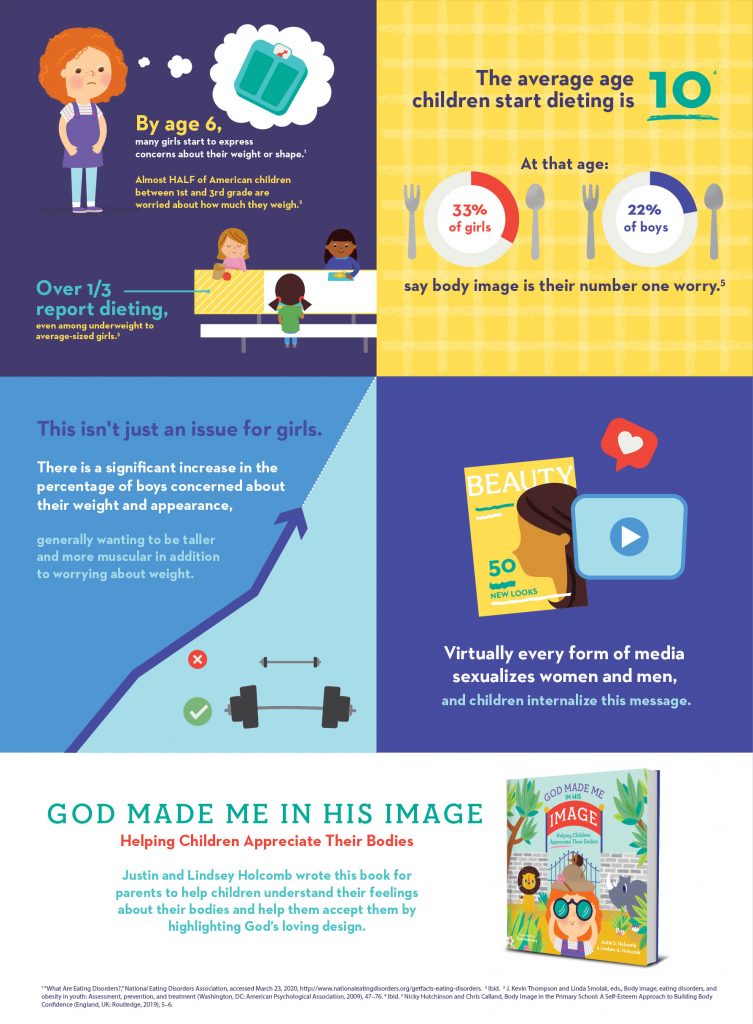
Justin: Let me jump in on this one since I just railed about the moms doing this thing. I hope there are a bunch of parents who are hearing this and there’s forgiveness. You have sinned against your child if you do that to them; there’s forgiveness for that. You just go get your forgiveness, go to Jesus, but let your behavior change. Be aware of that. I don’t want to just shame you and just dump the guilt of failure on your lap, there’s forgiveness from this.
Let me address the dads. Guess what? Your daughter is more than just a beautiful princess. If beautiful is the only adjective you have, you need to find a bigger vocabulary. This is more frustrating than the moms doing their thing because they’re smart, strong, kind, leaders and beautiful, but I’m surprised.
I’ve just started telling all my buddies who have daughters that they’ll take a picture and post it on social media. “Isn’t my daughter beautiful?” I’m like, “What else is she?” Or like, “Hey, this is my beautiful daughter.” I get it. I hear the adjective beautiful so much with regard to girls and young women, that I just have a look at the dads and say, “Hey man, expand that.” Because when you give that to her, it’s great, it’s great. I love the fact that you are actually referring to your daughter as beautiful and giving her a sense of self-esteem.
When that’s the only word you use, that’s her only worth. That’s what she brings to the world. That’s what she brings to the table, is her beauty. Do you really want her thinking that? Here’s the other thing, she is beautiful in God’s eyes. She’s beautiful in your eyes, but she’s going to think you’re crazy when she starts comparing herself to other people and realizing she’s not beautiful by the world standards or cultural standards.
I really think they are. You guys are like stunningly pretty, you’re really pretty, but you’re also an amazing athlete, you’re an amazing artist. You’re a really good friend, you’re really funny. I think that helps with some of this body image issues, is that we inadvertently step into it. No dad is trying to set up his daughter to only think of herself as beautiful, or with the boys, like, “Hey,” and it’s driving me bonkers. “He’s a little heart-breaker. All the girls are gonna like him.” It’s like, “Okay, first of all, it’s weird that you’re talking about your kid like that. He’s not a little stud.” “Do you know what that means? He’s a little stud?” Be a little bit more reflective of your words.
Is he a little bit more than just his looks, let’s try to set these kids up to hear something else besides being so looks-oriented. Are they godly? Maybe that would be a good one. This is my daughter. She’s beautiful, smart, and godly. That’d be a cool thing to say. To hear your dad say about you too. I’m a little fired up. I’m calmed down and ready for the next one.
Amy: I love that. It’s why all of these conversations today all relate together, because the words we say matter. How we’re communicating in front of our children, and to them, both of those things matter. Because it becomes the voice, or the vocabulary that they’re going to use in their own heads to think about the world, to think about themselves. I’ll have to go repent after we’re done and move on in the grace of the Lord there.

Helping our children develop positive body image
We’ve talked about things not to say, in front of our children or to our children. What are some positive ways that we can help them develop a positive image about their body?
Justin: I’m going to jump in on something Lindsey taught me about food. We could have talked about this in a previous question. I remember I came home one time again, and the girls are talking about “sometimes food” and “anytime food.” I’m like, that’s weird, like appropriate/inappropriate terms. “Why are we using these weird words for food?” And she was like, “Oh, because one of their friends talked about, ‘I can’t have that, that’s bad food,’” and she said, “Nope.”
Because again, that underlines kind of a disordered relationship with food. Dessert is not bad, it’s just not an every-time or anytime food. Certain things are anytime food and certain things are sometimes food. That for me is just helpful and a healthy way of relating. I’ll throw it back to Lindsey because that’s not specifically body image, but it was in the practical/what’s helpful on this topic categories. What would you say is a helpful way to encourage healthy body image?
Lindsey: I love that one that you mentioned. I think, you can just draw out like Justin was talking earlier when he was riffing, but just, “I love watching you play sports. I love seeing how strong you are. I love hearing you teach me about what you’re learning in school.” You’re just pulling out things that they’re really into at that moment; that’s going to change as the seasons change. If you find that your kid is in a rut or not really feeling very confident. It’s like, “Okay, you know what. We’re going to try some new things and let’s brainstorm.” Kind of a bucket list. What are some things that you really want to try? It could just be one-time kind of attempts. Let’s go try this new putt-putt place. Just kind of getting them out of their norm.
It could be, “Hey, you want to work towards trying out for the volleyball team. You might not be at the place where you’re ready to try out. What are some skills and different things you need to put in place so that you are ready for tryouts?” We had our oldest daughter, she played volleyball for the first time this fall on the school team. Then she started playing club this Spring. Club is in the off season, just to really get more practice and experience. She’s very green to it, and so she was on the bench a lot. There were just a lot of tears at home and that’s heartbreaking as a parent, but it’s like, okay, this is a chance to really grow some grit.
You’re on the bench. You can keep encouraging your teammates or you can sit there like a dud and just not be very encouraging. Let’s look into, you love the sport and you want to get better. Let’s reach out for some private lessons. Nnow she’s starting and she’s their go-to setter in just a matter of weeks. That’s not going to be every example for them and for every kid. For her to send that one sense of, “I can’t give up.”
I think grit is so important, more so than anything. It doesn’t matter where Justin I went to school. It doesn’t matter where we put them in school, but really building in that understanding of grit and trying things.
All that to be said, I think you can call out things that you see in your child that they’re not thinking of. Justin will regularly when he was putting the girls down, saying good night, he’ll talk to them about, “I really enjoyed you telling me that story. You have such quick wit. I love kind of just seeing how your mind works. Your brain is just going a mile a minute as you’re reading this book.” I think you’ve got at least one parent, or somebody in the family has got to be good about pulling out those things that you see. Because they’re not able to see that, they’re not developed enough and we aren’t even as adults. We get kind of down in our funk.
We need people that are going to speak those truths into us and be able to say, “I see God working on you in this way. I see what the Lord is doing in your life. He is making you such a kind friend to X, Y, and Z. He’s growing you as a leader.” There’s things like that. Then there’s also, “Let’s build a bucket list, because you are young and you’ve got things,” no matter your age. God has put you here to glorify Him and enjoy Him forever. We are going to try a lot of things that He has just put in our pathway. That can be small things. It could be, let’s go try this new smoothie place, or let’s go for a bike ride together. I think you’ve got to be intentional. Because if you’re not other voices are going to get to their head and they’re not going to be loving and kind.
Justin: I had a few more thoughts real quick, if you’re okay with that. Trying to get them not to compare themselves to their peers is huge. The way to do that, isn’t to say, “Don’t do that,” but like, “Hey, let’s look at what God made. Look like how different all these animals are, look how different people are.” Just getting them to see the variety. Imagine going to the ice cream place and you have 32 flavors and you only pick one, but you never enjoy the other varieties. God makes a lot of different things; you must enjoy that. Also being around, there’s different types of people and even different cultures that are a tad bit more body positive than others. My girls have pretty big eyebrows because I gave them that gift from those bushy eyebrows.
Kids started saying stuff like, “Why are your eyebrows so big?” They started feeling self-conscious. I was like, “Oh, hold on a second here.” I actually had them in a conversation with a stylist and she was like, “I cannot wait to get my hands on your eyebrows, those are amazing, you’re so lucky.” I started showing them pictures. I played the game probably horribly. I should’ve haven’t picked Brooke Shields and I was like, “This is Brooke Shields. She’s a famous model. She has huge eyebrows.” Then Madonna’s daughter, she’s a model like whatever age she is, but she has enormous eyebrows. I’m like, look, models, have big eyebrows.
Again, I’m not highlighting the sexualizing or trying to, but trying to find a way to be affirming of that.
Then again, I think the being sensitive to how you talk about your own health is going to be huge. I think it’s good for how the parents interact. I think good for them is for them to hear me complimenting my wife on how beautiful she is, but also how smart she is, how hardworking she is. It’s good for them to hear Lindsey say, “Hey, looking good honey. Here’s my man. There he is.” Then other things like how hard he works, that does amazing stuff for a child to be like, “Oh, that’s normal interaction.”
Of course my dad is not the most handsome man in the world. I tell them I am and they always laugh, but like, clearly he’s not, but that’s cool. This is what we’re looking for, someone who loves me like that. We’re not looking for everyone in the world to think I’m beautiful and amazing. Just setting the expectations, I think goes a long way for them.
Amy: Their identity being in who they are in Christ in the relationship of the family too, like you’re describing. It has to do with our family and we love each other. Not that we’re trying to please the whole world or be who everyone in the world wants us to be. I do want to bring up too, as a mom who has a couple of sons, I see on the flip side, you guys were bringing up like, only telling our daughters they’re beautiful and not also talking about like them being strong or smart and brave and these other things.
I can see it sometimes flipped the other way with boys where there can be a tendency to talk about just their like athletic ability, or something like that. We try to make a point, we have very athletic gifted sons and I love to watch them play, that’s great. Also to bring up, “Oh, I loved seeing the way you encouraged your teammates,” or, “Oh, I saw the way that you went over and comforted the person who made a bad play.” Those things are really important as well I think.
Justin: I think Lindsey had to leave cause we have daughters who need to be picked up. I do pick up the kids too, I actually pick them up all the time. I love that. I’m imagining a boy hearing his mom or dad just say something like, “Hey, you look really handsome today.” That is a really powerful thing, watching them flourish in the warmth of their parents’ affirmation. That’s a huge gift.
Find Justin and Lindsey Holcomb Online
Amy: Well, Justin, and tell Lindsey as well, thank you. Thank her as well for me. Thank you guys for taking the time to chat today. This has been incredible and I know will be an encouragement to a lot of parents. If anyone is wanting to learn more about either of these topics that we’ve talked about, what resources would you point them towards and then where can people find you guys on the internet.
Justin: Well, justinholcomb.com is where we have all of our books and a few articles. I have hundreds of articles, but some of them on these topics. We’re both on social media, Facebook (Justin and Lindsey) and Instagram (Justin and Lindsey), Twitter (Justin and Lindsey).
For topics on this, there’s a really good book a Christian psychologist name, Dr. Chirban, C-H-I-R-B-A-N on child sexual development. He endorsed our first book, God Made All of Me and I’ve really appreciated his stuff because he goes through all the way up to 18. How do you start talking about self-awareness of your body and puberty? We’re not dealing with puberty issues at all, we’re dealing with pre-puberty, but that book was a gift.
Jessica Thompson is another author who I really appreciate. She wrote a book with her brother about how to talk to children about sex. I think it’s called Mom and Dad, What’s Sex? It goes through some of these issues.
On body image, I just want to highlight what your main point was about who we are in Christ, identity in Christ. I don’t know where to start. There so many books on identity and something on Ephesians would be great, it’s a big identity in Christ book.
I know probably Trillia Newbell has some books on identity in Christ. Just find one of your favorite authors and see if they have something on identity in Christ. That’s going to be the foundation. Maybe some type of parents go in through the doctrine of creation, a lot comes from the doctrine of creation. Looking at Genesis of how God made them in his image and what that means, the dignity of that. Those are the places I would start off with.
Amy: That’s fabulous. I’ll have links to those things in the show notes for this episode over at www.humilityanddoxology.com. Thank you so much and I look forward to chatting with you guys again.
Justin: Well, thanks for the opportunity to be here, Amy. This is an honor and it’s fun to just talk about these and such wonderful questions that you’ve pulled out of me and Lindsey. Ways that we’ve had to talk about things differently than we’ve been asked before. Thank you very much.
Check out all the other interviews in my Homeschool Conversations series!
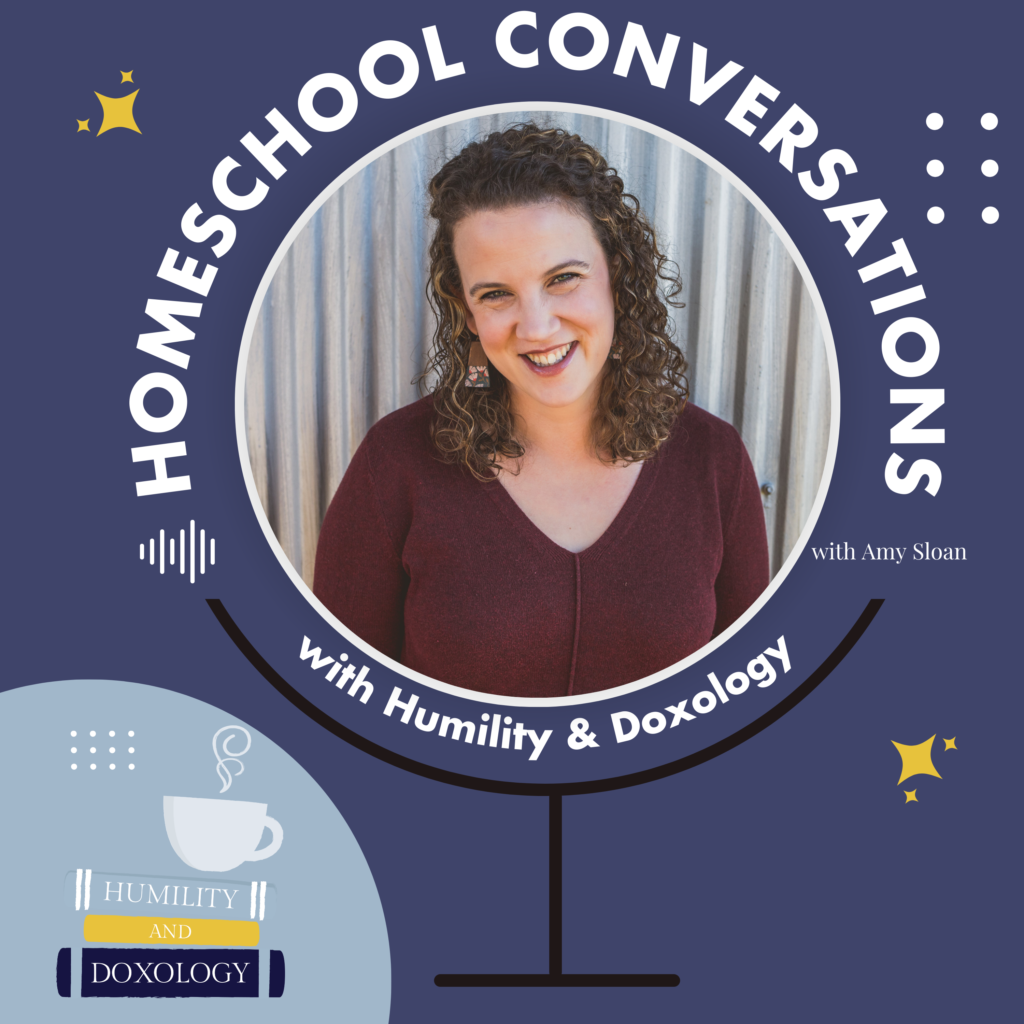

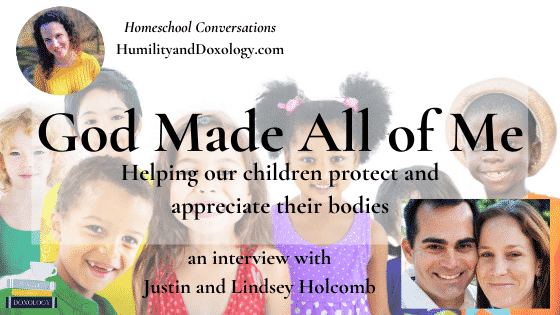
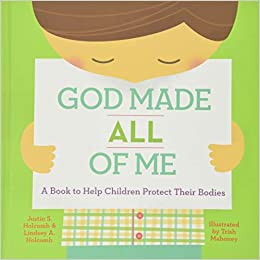
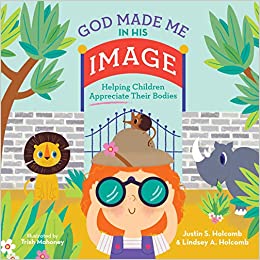
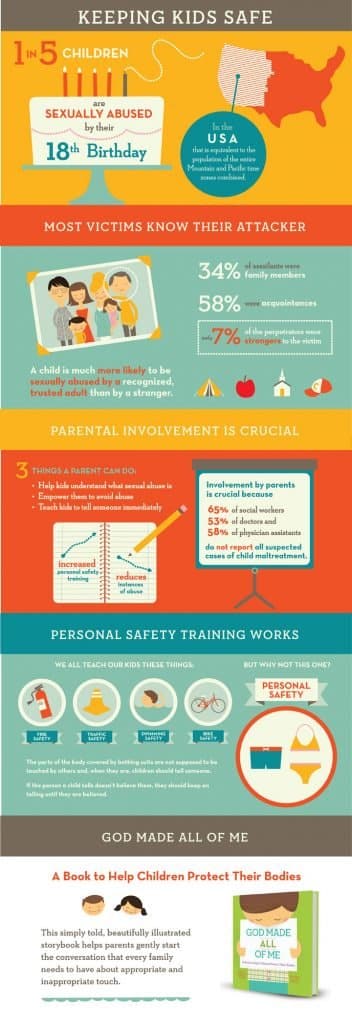

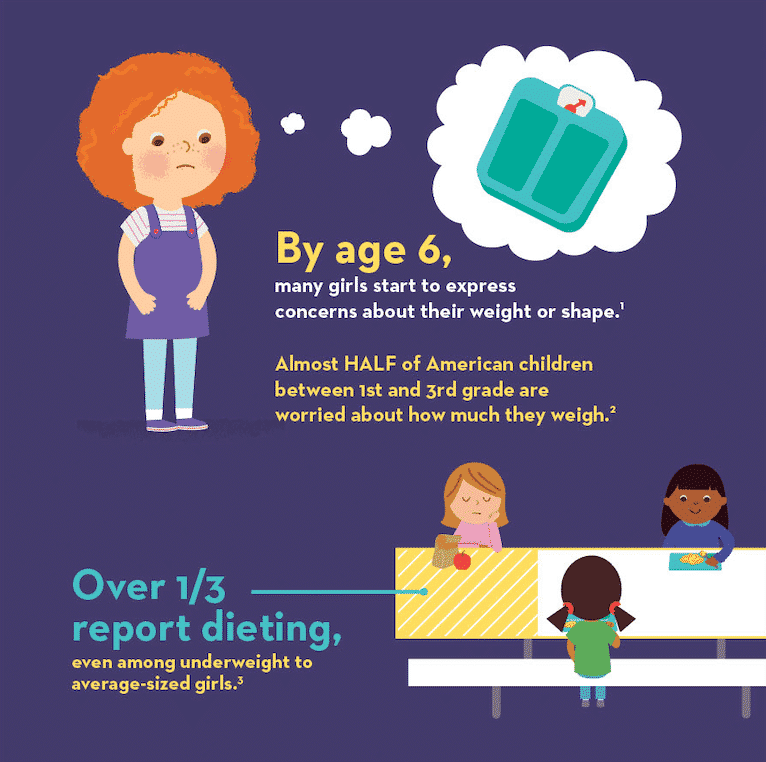

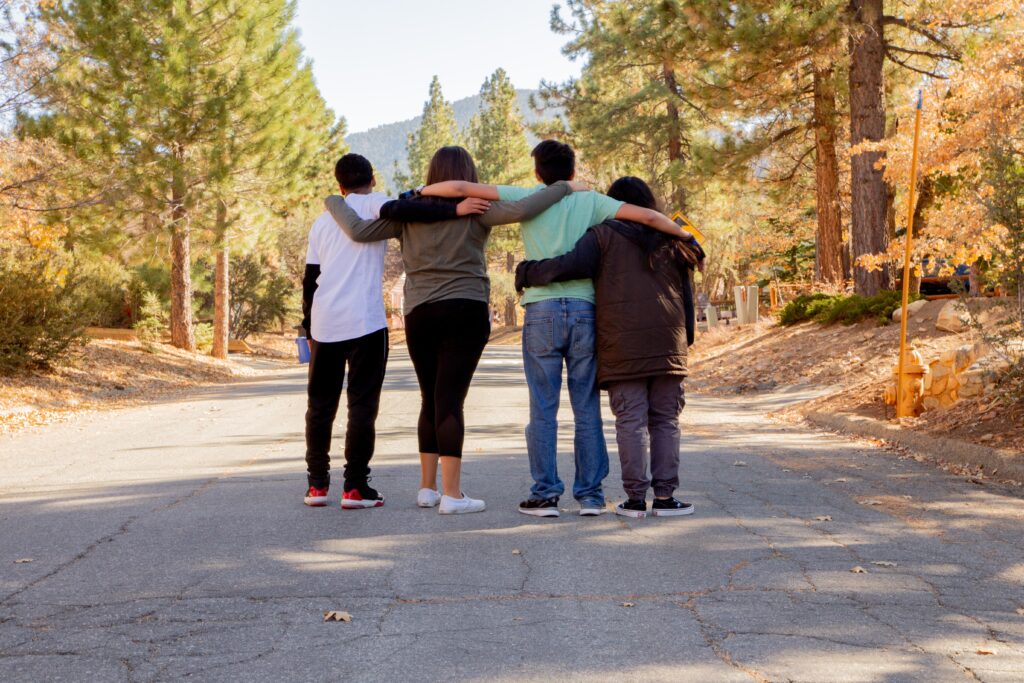
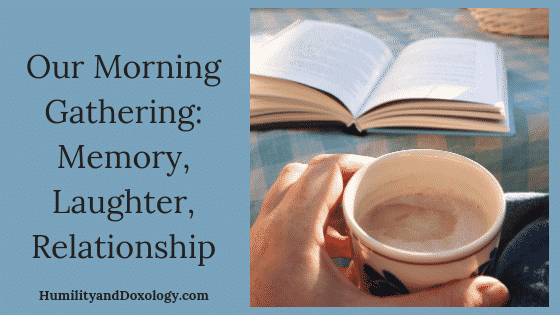
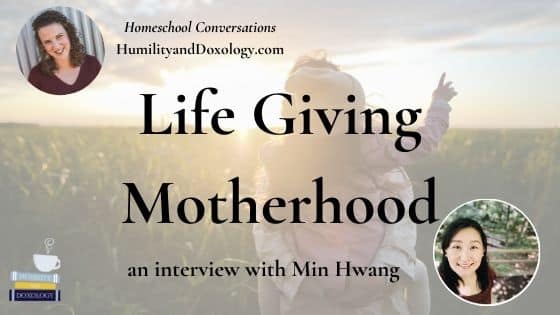
Thank you for this interview! I am excited to get these to read with my kids.
Yay, I’m so glad you enjoyed the interview! I hope your kids enjoy the Holcombs’s books as much as mine do. 🙂